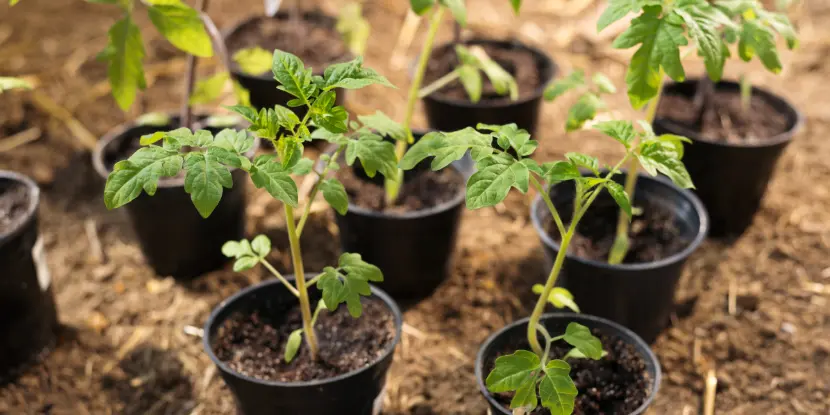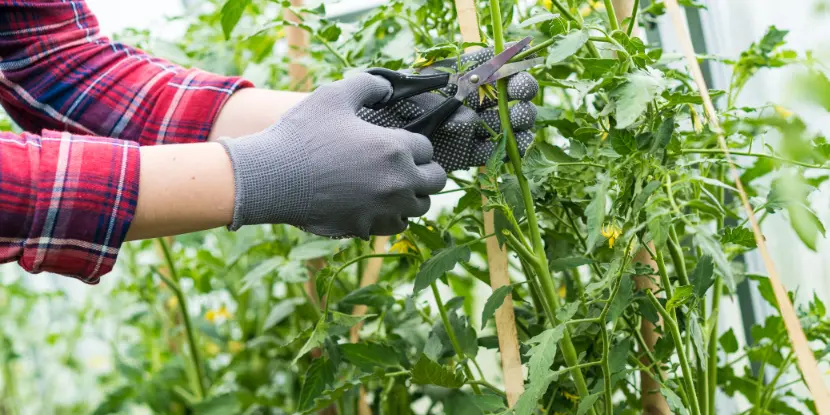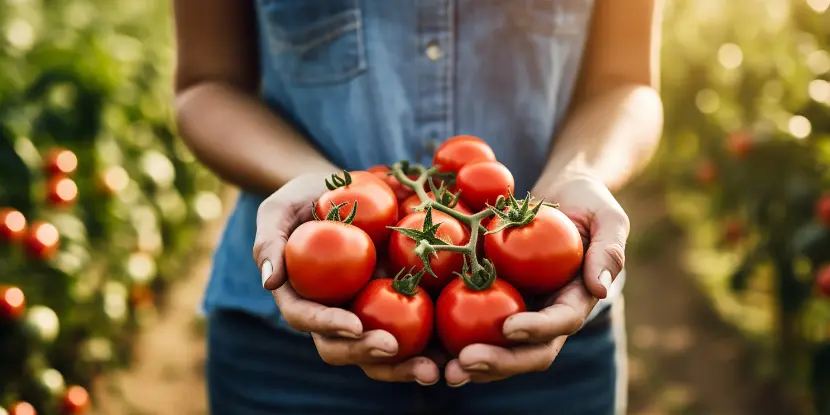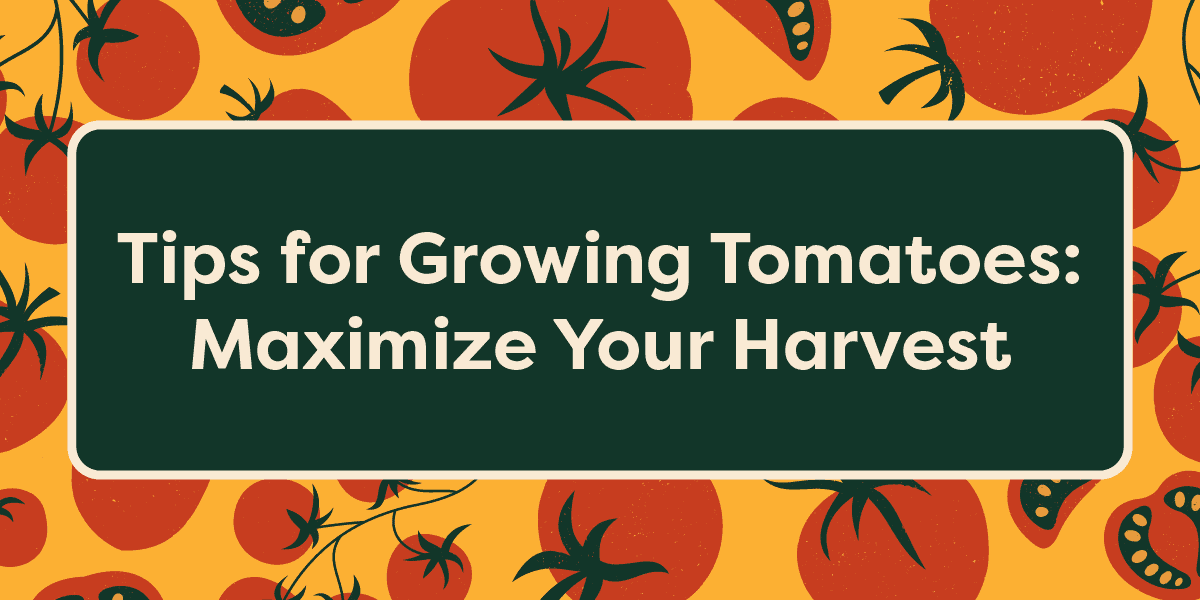Tomatoes are the most popular vegetable for home gardening. They’re relatively easy to grow, remain productive all summer, and can be grown in containers, raised beds, and on ridges.
There’s nothing like the sweet, rich flavor of a freshly picked tomato from your garden. No grocery store tomato compares.
Two plants should produce enough tomatoes (10 to 30 lbs/plant) for the average family. If you’re a tomato mega-consumer or plan to process some fresh fruit into tomato juice, can, or freeze them, you should adjust the number of plants accordingly.
Growing Early Tomatoes
In early March, select early-maturing varieties with thick-purplish stems.
- Make sloping trenches from two down to three inches deep.
- Cut the bottom leaves off the plants.
- Lay the root balls in the deepest end of the trench.
- Cover the root balls and stems and turn the cluster of leaves up, or make shallow holes and set the plants in them.
- Cover the plants with suitable cold protectors, insulated cages, etc.
Apply a water-soluble plant growth stimulant each week or two. After the plant is set, use the milk/mixture on the soil around each plant:
- Week 1: 2 teaspoons milk/cup water
- Week 2: 4 tsp. milk/cup water
- Week 3: 6 tsp. milk/cup water
- Week 4: 8 tsp. milk/cup water
- Week 5: 10 tsp. milk/cup water

Young tomato plants before transplanting.
Remove cold protectors when the temperatures warm and the plants are established.
Under optimal conditions, tomato plants can double or triple their size after you’ve removed the cold protectors, given they have adequate sunlight, water, and nutrients to support their growth.
Re-pot small plants into larger containers. After a week or two, pinch off the lower leaves and re-pot them into larger containers to grow more roots before planting.
If temperatures fall below 50 degrees F, move potted tomato plants to a warmer area. They may have flowers and small fruit before transplanting them into the garden in late March or early April.
Early Tomato Care
- Water young tomatoes every other day during the cooler months.
- You can make a root-watering system out of plastic milk jugs. Cut holes in their sides and bury them between the plants.
- As the tomato plants mature and the weather warms, gradually reduce watering to encourage deep root growth.
- Mature plants typically need watering once or twice a week in Southern California.
- Deep, infrequent watering helps develop a robust root system, making the plants more resilient and productive.
- Apply a tablespoon or two of water-soluble fertilizer each week or two.
- Spray the flowers twice each week with a “blossom set.”
- Root prune the plants after they have three or four clusters of small tomatoes.
- If the plants were set trenches, cut about nine inches deep and two inches from one side of the buried stem.
- If the plants were set in holes, cut about nine inches deep and two inches away from and halfway around the stem.
- Apply dark-colored mulch around the tomato plants when the soil is cool, then change to white or light-colored mulch and increase the amount as the soil warms.
Transplanting Tomatoes to the Garden
- Dig holes about one foot deep and place organic matter (compost, cobs, banana peelings, etc.) in the bottom.
- Set the plants down to their lowest branches to develop roots along the buried stems.
- Apply growth stimulant, water, fertilizer, and mulch, as described above.
- After transplanting, apply the same weak milk solution to the soil around each plant.
- If weeds appear, apply a thick layer of wood chip mulch or newspapers (three sheets thick) topped with straw to prevent further weed growth and keep the soil moist.
- Use cages or stakes for support, and remove suckers (side shoots) that grow from the plant’s base.
- Water your tomatoes deeply once a week or more often in hot weather.

Transplanting a young tomato plant in the garden.
Tomato plants should be mature enough to set fruit before the summer heat. With most varieties, flowers won’t develop fruit when nighttime temperatures drop below 60 degrees, rise above 75, or daytime temperatures exceed 90 degrees F. Warm days with cooler nights are ideal for developing fruits with the best flavor and texture.
The harvest season for early varieties may begin in early May. Mid-season varieties should peak in July through September in Southern California, marking the optimal harvesting window.
General Care for Tomatoes
Tomatoes are heavy feeders. Apply a balanced fertilizer regularly.
- Deep water your tomatoes once a week.
- Increase the watering frequency to at least twice weekly in hot weather to ensure the soil remains moist.
- Always check the top 1-2 inches of soil for dryness before watering again. If the soil feels dry, it’s time to water.
- During extreme heat waves, you may need to water daily, especially potted tomato plants or smaller varieties that dry out faster.
- Yellowing leaves can indicate a lack of water or fertilizer. Check the soil moisture and consider applying an organic fertilizer.
- Prune your tomato plants to remove any damaged or diseased leaves, as well as suckers that take away energy from producing fruit.
- Common pests include aphids, whiteflies, and hornworms. Consider natural pest control methods, such as releasing beneficial insects or using homemade sprays from garlic or hot peppers.
- Look for signs of disease, such as wilting, yellowing leaves, spots, and discoloration. Rotate crops yearly to prevent the buildup of diseases in the soil.
- Harvest your tomatoes by gently twisting them off the vine when they’re ripe but firm. Tomatoes will continue to ripen after being picked, but it’s best to let them fully ripen on the plant for optimal flavor.

Pruning a tomato plant for optimal growth.
Increasing Tomato Fruit Production
A large, bushy tomato plant or vine with smaller fruit and low fruit production could mean that:
- Soil was too fertile for the growing plant
- Direct sunlight was less than eight hours per day
- Plants were overwatered before fruits were set
To boost fruit production and size:
- Apply one tablespoon of fertilizer each week several times after the first fruits have been set.
- When the first fruits are about one-half of their mature size, apply two tablespoons per week for as long as the plants stay productive.
- Add a thick mulch for two to four feet around the plants to keep the soil moist and cool, prevent weeds, and prevent fruits from contacting the ground.
- Tomatoes should be deeply watered once a week under normal weather conditions.
- In hot weather, watering frequency should increase to at least twice a week to ensure the soil remains moist and avoid stressing the plants.
- Always check the top 1-2 inches of soil for dryness before watering again. If the soil feels dry, it’s time to water.
- During extreme heat waves, daily watering might be necessary, especially for potted tomato plants or smaller varieties that dry out faster.

A harvest of delicious home-grown tomatoes.
FAQs: Growing Tomatoes
Q: What type of fertilizer should I use for my tomato plants?
Apply a balanced, water-soluble fertilizer. Start with a tablespoon or two each week or two, and adjust as the plant grows and fruits set.
Q: How can I increase the fruit production of my tomato plants?
Ensure direct sunlight for at least eight hours per day, avoid overwatering before fruits are set, and apply additional fertilizer as the first fruits reach half their mature size.
Q: When is the best time to harvest tomatoes for the best flavor?
Harvest when the tomatoes are ripe but still firm. Allowing them to ripen on the plant yields the best flavor.
Q: How can I prevent common pests from damaging my tomato plants?
Use natural pest control methods, such as releasing beneficial insects or applying homemade sprays from garlic or hot peppers.
Q: What are the signs of disease in tomato plants, and how can I prevent them?
Look for wilting, yellowing leaves, spots, and discoloration. Prevent diseases by rotating crops yearly and removing any diseased foliage promptly.
Q: How deep should I plant tomatoes when transplanting them into the garden?
Dig holes about one foot deep and set the plants down to their lowest branches, so roots can develop along the buried stems.
Q: Can tomatoes grow in pots, and if so, how does care differ?
Potted tomatoes may require more frequent watering, especially during hot weather, and good drainage is crucial. You might also need to adjust the amount of fertilizer according to the pot and plant size.
Q: How should I prune tomato plants for optimal growth and fruit production?
Remove any suckers that appear below the first flower cluster, as these can divert energy from fruit production. For indeterminate varieties, it’s beneficial to thin the foliage to allow more light and air circulation, which reduces the risk of disease and increases fruit size.
Q: Is it necessary to rotate tomato plants yearly, and why?
Crop rotation is crucial to prevent diseases and pests from building up in the soil. Tomatoes shouldn’t be planted in the same spot more than once every three to four years.
Q: Can I grow tomatoes indoors?
Tomatoes can be grown indoors under the right conditions. They’ll need lots of light, at least 8 hours of direct sunlight, or 14-18 hours under grow lights. Indoor tomato plants also need proper air circulation and consistent temperature control. Choosing dwarf or determinate varieties usually works best for indoor gardening.

